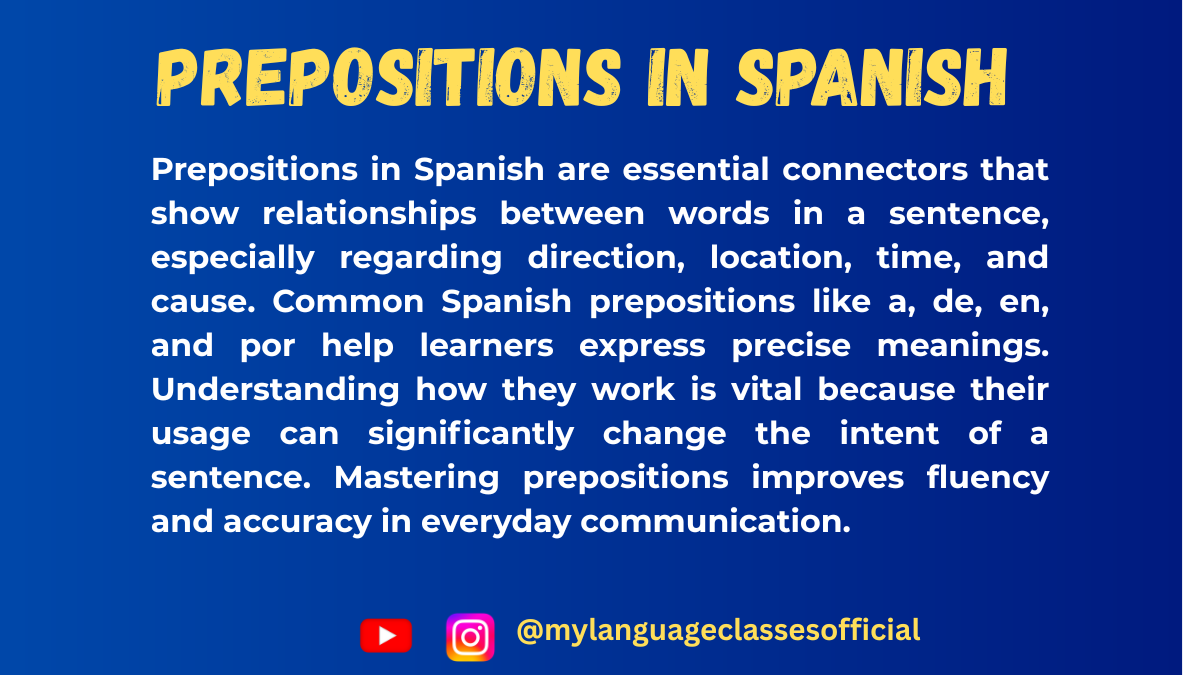Your cart is currently empty!
Prepositions in Spanish

Mastering Prepositions in Spanish
Learning Spanish prepositions can seem tricky at first, but they’re essential for mastering the language. Prepositions are words that establish relationships between elements in a sentence, such as place, time, or cause. In this post, we’ll explore prepositions of place, prepositions of time, and other key types of prepositions in Spanish, with practical examples to enhance your understanding.
1. Prepositions of Place (Preposiciones de lugar)
Prepositions of place indicate the location of an object or person in relation to another. These are some of the most common:
| Preposition | Meaning | Example |
|---|---|---|
| en | in/on/at | El libro está en la mesa. (The book is on the table.) |
| sobre | on/above | La lámpara está sobre la cama. (The lamp is above the bed.) |
| bajo | under/below | El gato está bajo la silla. (The cat is under the chair.) |
| entre | between/among | La tienda está entre el banco y la farmacia. (The store is between the bank and the pharmacy.) |
| al lado de | next to | Mi casa está al lado de la escuela. (My house is next to the school.) |
| frente a | in front of | El coche está frente a la casa. (The car is in front of the house.) |
Common Pitfall:
Learners often confuse en (in/on/at) with a (to/at). Remember:
- En emphasizes location (Estoy en casa = “I am at home”).
- A indicates motion or direction (Voy a casa = “I’m going home”).
2. Prepositions of Time (Preposiciones de tiempo)
Prepositions of time indicate when something happens. Here are key examples:
| Preposition | Meaning | Example |
|---|---|---|
| a | at | Nos vemos a las cinco. (We’ll see each other at five.) |
| en | in/on | Nací en marzo. (I was born in March.) |
| desde | since/from | Trabajo aquí desde 2018. (I’ve worked here since 2018.) |
| hasta | until | Estaré aquí hasta las tres. (I’ll be here until three.) |
| durante | during | Fuimos a España durante las vacaciones. (We went to Spain during the holidays.) |
Note:
The prepositions a and en often cause confusion when talking about time. For instance:
- Use a to refer to specific hours (a las siete = “at seven”).
- Use en for months, years, or periods (en abril = “in April”).
3. Other Common Prepositions
Beyond place and time, prepositions convey various relationships like cause, manner, or possession.
| Preposition | Meaning | Example |
|---|---|---|
| de | of/from/about | La casa de Juan es grande. (Juan’s house is big.) |
| por | for/because of/by | Gracias por tu ayuda. (Thank you for your help.) |
| para | for/to/in order to | Este regalo es para ti. (This gift is for you.) |
| con | with | Voy al cine con mis amigos. (I’m going to the movies with my friends.) |
| sin | without | No salgas sin paraguas. (Don’t go out without an umbrella.) |
Por vs. Para:
- Por often indicates a reason or means (Lo hice por amor = “I did it out of love”).
- Para suggests purpose or destination (Lo hice para ti = “I did it for you”).
4. How to Master Spanish Prepositions
- Practice with Context: Prepositions often don’t translate directly, so practice them within phrases.
- Memorize with Mnemonics: Use memory aids for tricky pairs like por and para.
- Engage in Real-Life Usage: Try journaling, speaking, or chatting with native speakers to reinforce prepositional phrases.
- Use Visual Aids: Draw diagrams to represent relationships like location (sobre = above, bajo = below).
Conclusion
Understanding and using prepositions correctly is a vital step in becoming fluent in Spanish. While their nuances may seem challenging, consistent practice and exposure will make them second nature. Whether you’re talking about the book on the table (sobre la mesa) or planning a meeting at five (a las cinco), prepositions allow you to express complex ideas with precision.
What are your biggest challenges with Spanish prepositions? Share your experiences in the comments! Let’s learn together. 😊
If you found this guide helpful, I’d love to hear from you! Share your thoughts in the comments below or connect with me on social media. For more tips, resources, and inspiration, visit my blog at mylanguageclasses.in. Follow on Instagram and subscribe on YouTube
📚 Continue Learning Spanish
Vikas Kumar is a dedicated language educator, content creator, and digital entrepreneur, best known as the co-founder of My Language Classes and The Curious Mind. With a strong focus on helping learners achieve fluency in English, Spanish, and Japanese, he has guided audiences worldwide through a diverse range of resources, including in-depth blog articles, engaging YouTube tutorials, and comprehensive Books.
Through My Language Classes, Vikas has built a thriving multilingual learning platform that serves students, travelers, and professionals eager to master communication skills for personal, academic, and professional success. His expertise extends to exam preparation for internationally recognized certifications such as JLPT, DELE, IELTS, and TOEFL, enabling learners to achieve tangible, career-enhancing results.
As the founder of The Curious Mind, he also explores broader areas of knowledge, including self-help, motivation, modern learning strategies, and thought-provoking insights on life and personal growth. His work blends practical teaching methods with a deep understanding of learner psychology, making complex concepts accessible and engaging.
Driven by a mission to make high-quality education accessible to all, Vikas continues to expand his reach across multiple platforms, including YouTube, blogs, eBooks, and social media communities, inspiring thousands to learn, grow, and embrace lifelong learning.


Leave a Reply